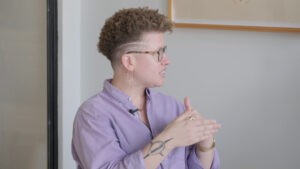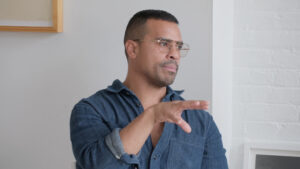Recess, New York
In conversation with Shaun Leonardo, Lindsay C. Harris
This interview excerpt is part of FCCW’s development of a co-leadership model, learn more here.

Shaun:
When I was brought into the conversation, toward the end of 2020, what I understood, and what I still really appreciate, was that the notion of a shared leadership model was being constituted around the possibility of honoring visionary leadership from an artistic viewpoint. What do artists specifically — in their thinking, in their strategizing, in their ways of being — bring to the table, and how might you codify that into executive leadership? That is the space I wished to move into.
And what I really tried to, therefore, bring, was almost an application of my artistic practice to how an organization might not only run but also see itself. That thread is certainly still here, in terms of not only the confidence we have in a co-directorship model, but the ways in which, more holistically, the organization attempts to move. If we have to see ourselves within the confinements of the nonprofit industry, what are the ways in which we can create space and find strategies to think about our operations — both external programming and partnerships, and internal mechanisms — as an artistic project versus a static organization?
Mandy:
Love that.
Lindsay:
Definitely… Since I wasn’t here at Recess then, every very time I hear Shaun, Allison [Allison Freedman Weisberg, Recess founder and former Co-Director], or other people who were a part of that process speak on it — I’m gaining layers of new understandings too. One thing I’ll add from what happened at that time that feels really different than what’s now happening with us, is that it was both, as Shaun said, about honoring artistic leadership paired with executive or administrative leadership and also about power shifting with white accomplices, like ceding power in a way for—
Shaun:
Divestment.
Lindsay:
Divestment from a certain type of privilege and power rooted in white supremacy, in the art world specifically, and honoring artists and youth of color–not only in the implementation of co-directorship, but more broadly. That’s in much of the language and what likely felt urgent at that time across the organization with staff, and the board, with Allison, as the white woman founder, and all of that. While that paved the way for this moment, the impetus for a co-directorship at that time, is not the leading framework in which we are in now.
So that’s the part that’s a bit sticky…that we’re working through as a new leadership team, as co-directors and staff. It’s one of the things I do appreciate so much about Recess– the idea to experiment, to try things out, like the artist project in its constant iterativeness, which was really bold to name at the time. What was the push and how are we building on this legacy? As Shaun’s talking about, it was perhaps like, “Okay, let’s make these moves,” and now we’re kind of sitting with, “Alright, what does this mean for who we are now, our current staff, our current programs? Does it still work?” Everything is needing to shift right now.
Mandy:
I’m curious. I don’t know if I’m hearing this correctly, but I think what I’m hearing suggested is that there were decisions and working styles that were maybe changing in a more person-to-person, responsive, I’ll say organic way, and then it sounds like you all are talking about a set of changes or a set of communications or a set of formalities that needed to take place, after further thinking had been done about co-leading. So I’m curious, what you can decide within your organization. Okay, this is how we’re going to work, this is how we’re going to pay ourselves.
And so then, I guess the question is what are the formalities? Perhaps they were in bylaws, perhaps they were in job descriptions, perhaps they were in communications that you all took after or maybe alongside some of that ideation? I’m also curious if you can reflect on what the pros and cons of — I’m hearing that there’s a board — the board also changing their leadership model. I personally have been on the Recess mailing list for a long time, so I’m aware of how you all spoke through the change, and I’m curious, what were some of the pros and cons of having to take some of the changes that were being felt and orchestrated and then report out or change structures in a more formal way?
Shaun:
Let me try to wrap my head around the question, but I’m going to do so with my attempt at a response.
Mandy:
Okay.
Shaun:
Those foundational stages for the org centered ideation. Though, from what I gathered, those conversations did lead to immediate structural shifts—primarily around universal salary adoption, the co-chair model and co-directorship model, healthcare for all employees regardless of part-time or full-time status along with a full benefits package, and a revision of the employee handbook and bylaws. Now that really set the stage, from my understanding, for further evolution. However, simultaneous visioning work alongside structural remaking does bring a certain messiness. But one can’t really be felt or find some solidity without the other.
In the experimentation it became really necessary for me to annunciate on behalf of the org that we didn’t necessarily have it right. It wasn’t that we figured something out.The bravery, the daringness came in asking difficult questions of ourselves and the org and in experimenting. I still feel that is at the core of our job — to, as best as possible, indicate that we are willing to take these steps. Not that we are fully confident that each shift is going to work and find a place within this organization or for the people within this organization, but rather, that we have some conviction around those moves based on a value set.
Lindsay:
For sure. Well, I will say for me, I came into this role because it was a co-directorship. If it was not, I would not have wanted it, period. I think a lot of that is because there’s so much beauty in collaborative work and in shared power. I believe it’s incredibly valuable for accountability, for example, to have shared thought leadership in the executive decision making. When it’s important decisions that affect people’s lives in whatever way that is, to do that consistently alone, is not equitable. So that’s part of the ethos that we share, certainly. And then I think for me coming in — and you heard a little bit of Shaun’s trajectory in the organization — a lot of where we’ve been at is trying to understand where we are as an organization, and as two humans and as leaders. Even though we have known each other a while, we’re definitely getting to know each other a lot better now.
It’s a different level of intimacy and partnership. Then trying to understand what our leadership is in relation to shared power with the rest of the staff and in the context of our larger community of youth and artists. For the first time since the implementation of a universal salary, is there a difference in salary between the co-directors and the rest of the staff, for example. That was decided collectively in order to hire for what is now my position. So there’s a lot that’s shifted in order to allow for someone new to come in, and needs to shift now that we’ve got all of us humans here. So things like that have a huge impact on how we move from the job descriptions and ways of working before, to understand what it needs to be now. We’re in a fortunate place to have some fiscal sustainability, for the moment, around transition, where we’re not scrambling to have to make decisions about money, so that we can slow things down and make more decisions about operation.
A lot of it’s about operationalizing those value sets and the things that have been in practice with Recess for so long. Now in this moment of shifting to leadership of color, and trying to work out the kinks of what is artistic practice, what is administrative, executive…what feels right for us in our experience previous to now? I come from a youth leadership background, so feeling out where that can be most useful here. We’re talking about dividing responsibilities programmatically so we each take on a core program area as lead, and splitting up some other core areas like operations and development. As I’m in my first few months at the organization, I’m still learning a lot overall and that’s going to take a while. But we’re already seeing, I think, where it becomes hard. We can’t both be involved in everything, and it’s also still a small organization, so there’s a level of that that is totally possible. I think just trying to feel that out in relation to practicality, power and values. Yeah. I’ll stop there.
Shaun:
You really covered it all. I think what attracted me to the co-directorship, just to make that explicit, was the experiment of non-hierarchy, and I think what Lindsay’s also noting is that we come into this space with the experience of all of our institutional roles. It’s, therefore, an active process of questioning what I can do differently. What can I shed? What can I abandon from these previous institutional actions? How do we create an environment for existing with one another differently in order to collectively do this mission driven work?
And this piece around it being antiquated and inhumane for all the pressure to fall on one individual is very real. I just want to echo and reiterate that. But there is also another consideration here. In the decision-making and in having to hold much of the responsibility of how the organization moves… at the end of the day I must reckon with, and I’ll speak for myself, my own limitations of practice and thinking? How does thought partnership, therefore, fill that gap as well? There are ways that this organization needs to move that I know, for myself, I may not even see. So how do you bring in support? How do you bring in the necessary visioning? How do you bring in the partnership that is going to get the organization where it needs to go?

